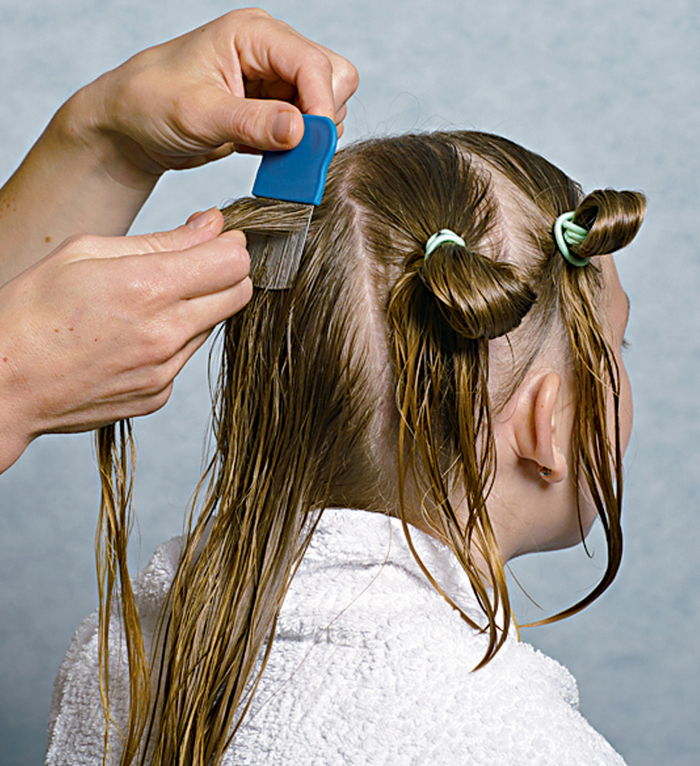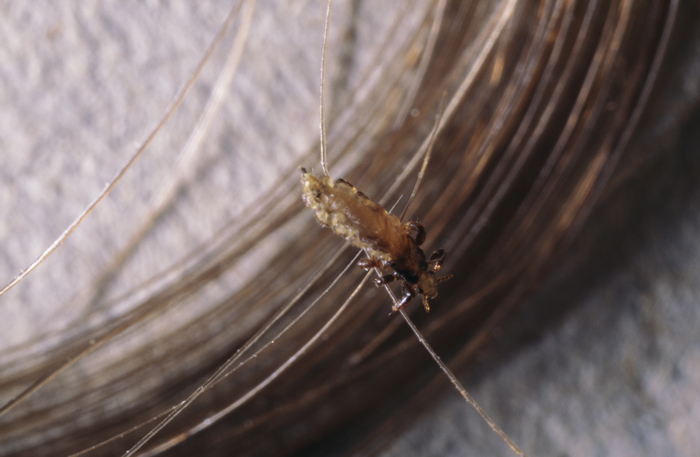Symptoms of head lice
An itchy scalp is a common sign of head lice. Lice suck blood, and lice bites can cause itching. You can also get sores and scalp infections from scratching the lice bites.
Many people do not itch, so remember to check!
Many people with lice do not itch. It can also take many weeks from when you are infected to when you start to itch. That is why it is important to check for lice regularly, whether you are itching or not.
Lice check - how to do it
You can check for lice in damp or dry hair. When checking in damp hair, the lice are less able to move, and more likely to stick to the lice comb. In dry hair, lice move and may be easier to spot. At the same time, you must be aware that combing dry hair creates static and lice may be thrown from the comb back into the hair.
The lice comb needs a thorough wash at 60 ºC or to be frozen for at least four hours before others use it.
Lice check in damp hair
- Wet the hair and add conditioner if desired.
- Place a white towel over the shoulders.
- Use a lice comb.
- Be systematic and carefully comb through all the hair from scalp to hair tip.
- Wipe the comb regularly on a piece of paper to check for lice. After a few minutes, you will see lice moving if there are any.
- Also check both the towel and comb for lice and eggs.
- Use a magnifying glass and good light. This makes it easier to spot both lice and eggs.

To find head lice in long hair, it is a good idea to divide the hair into 3–6 ponytails and comb one ponytail at a time.
Illustration: Lene Solbakken, Norwegian Institute of Public Health
Checking for lice in dry hair
- Have the person being combed stand bent over a large white sheet.
- Comb from the scalp down towards the sheet.
- Check both the sheet and the comb for lice and eggs.
Checking for lice and treating head lice (in Norwegian)
What do head lice and eggs look like?
Head lice are light, brown or black. They are somewhat transparent and may have a reddish tint if they have recently sucked blood. Adult lice are 2-3 mm long. Nymphs (young lice) are smaller and lighter in color.
The eggs (nits) are 0.3 x 0.8 mm, and they are firmly attached to the hair, even after they have hatched. Unhatched eggs are yellowish white and transparent, hatched eggs are papery white.
Lice eggs or scabies/dandruff
Some people confuse scabies or dandruff with lice eggs. Lice eggs are oval and they stick so well to the hair strand that the hair often breaks during combing, with the egg still attached. Dandruff is often uneven, flaky and easier to brush out of the hair.
What do you do if you discover lice or eggs?
If you discover lice, you should start treatment as soon as possible – preferably the same day. If you find eggs, it may be a sign of a lice infestation, but the eggs may be hatched or dead and therefore not a sure sign of an ongoing lice infestation. Eggs close to the scalp have been laid more recently, so eggs attached more than 1 cm from the scalp have already hatched or died.
If head lice are discovered in children in daycare or school, it is unnecessary to send the child home. The child has probably had lice for some time, so a few hours more or less make little difference. The child can go to daycare or school as normal after the first treatment.
Head lice are not dangerous but can be troublesome for the person affected.
Remember to inform the kindergarten, school and circle of friends
The kindergarten, school and circle of friends must be informed that the child has head lice, so that those who have had contact with the child can be checked for lice. The school or childcare center should inform other parents or guardians that lice have been detected within the school grade/department. They must encourage the parents to carry out a lice check and refer to this website for information about lice checks and treatment.
Treatment to get rid of head lice
Head lice can be combated using:
- lice treatment from the pharmacy
- combing with a lice comb
- shaving the hair
If several people in the family or circle of friends have lice, those who are infected should be treated at the same time to prevent new infections.
Check your hair with a lice comb weekly for three weeks after the last treatment to see if you have gotten rid of the head lice.
Treatment with pediculicides
There are several types of delousing agents, also known as pediculicides, that you can buy at the pharmacy. It is important to follow the enclosed instructions carefully, regardless of which product you use.
Remember that only the person or people who have lice should be treated with lice treatment, because there is always a small risk of side effects.
Pediculicides with dimethicone are recommended. Dimethicone is a silicone substance that kills lice mechanically.
Products with permethrin are not recommended due to resistance.
Lice treatments that contain plant oils and other ingredients may also be effective, but this is not as well documented.
Pediculicides are often less effective against lice eggs. For most products, treatment must therefore be repeated after 8–10 days. During this time, surviving eggs will have hatched, but the new lice have not yet reached sexual maturity and have therefore not laid new eggs.
Treatment with a lice comb
Treatment with a lice comb is time-consuming. You should comb the hair systematically and thoroughly every day or every other day for 12–14 days. The hair should be wet, and you may wish to add conditioner. Dead and empty eggs can remain on the hair for a long time after the lice have been removed from the head. It is not necessary to remove these eggs.
When using a lice comb, lice can fall from the comb onto the child's shoulders, and possibly crawl back up into the hair. Place a light-colored towel over the shoulders, making it easier to spot and remove the lice.
Afterwards, both the towel and comb must be washed at 60 ºC or frozen for at least four hours, to kill lice and eggs.
There is also a special hot air device that can be used for combing, where the lice dry out during the treatment. The device is not for home use.
Shaving
Lice cannot survive in hair that is shorter than half a centimeter. Shaving can therefore be a good alternative.
Be aware that lice will crawl around in the cut hair after shaving. Some lice will also try to stick to hair stubble on the head. Use a lice comb to remove these.
Treatment of objects
There is a certain possibility that lice can spread via combs and brushes. Wash or freeze them if there are head lice in the household. Combs and brushes should be frozen at -20 ºC for at least 4 hours or washed thoroughly at 60 ºC.
Transmission from other objects is unlikely, and it is not necessary to wash clothes, furniture, or the rest of the house if somebody has head lice.
How do head lice spread?
Both adults and children can get head lice. Lice are transmitted through head-to-head contact. They cannot jump or fly, but crawl from hair to hair.
You can get lice regardless of hair type, and lice have nothing to do with personal hygiene. Regular hair washing does not kill lice or lice eggs, so it does not matter how often you wash your hair.
There is little chance of getting lice that are not in someone else's hair. They quickly become weak and survive a maximum of 1-2 days away from a head.
How often should you do a lice check?
All families should check the entire household for lice as often as possible, preferably once a month. In addition, you should have a thorough lice check immediately if you hear about lice in your circle of friends or suspect an infestation.
To prevent infestation, all parents should check their children at the start of the school year and after holidays. The Directorate of Health encourages all schools and kindergartens to initiate a head lice campaign every year on the weekend of weeks 10 and 35 (after the winter holidays and after the summer holidays). If everyone checks at the same time, the spread of lice will be reduced.
Infrequent lice checks are an important reason why it can be difficult to get rid of head lice in a community. By checking more often, head lice are detected sooner, and fewer people will unknowingly carry head lice and risk spreading them to others.
More about head lice from the Norwegian Institute of Public Health
When should children stay home from childcare?
Children who attend centre-based childcare are exposed to different types of infection. The child's general condition will usually dictate the need to stay at home for some days, but some infectious diseases may require a longer absence to prevent transmission to others.
